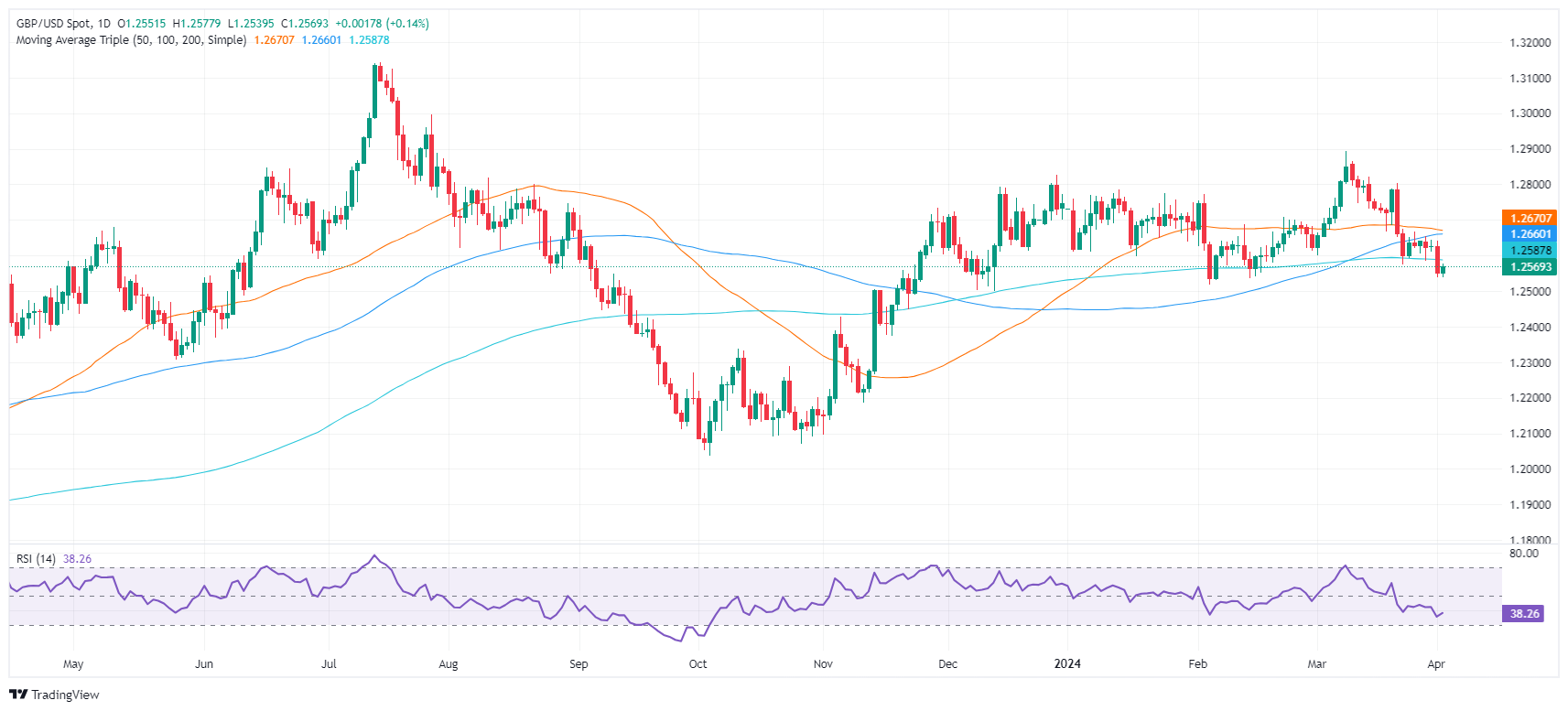GBP/USD recovers amid solid US economic data, Fed comments

- GBP/USD climbs to 1.2573, rebounding amidst rising US Treasury yields and mixed signals from Fed officials.
- US job openings slightly exceed expectations, while Factory Orders show robust growth, impacting Treasury note rates.
- UK manufacturing sector returns to expansion, boosting Sterling ahead of upcoming service sector data.
The Pound Sterling registered solid gains on Tuesday after diving to a one-month low of 1.2539 on Monday as European financial markets were shut off due to a holiday. At the time of writing, the GBP/USD trades at 1.2573, a gain of 0.18%.
GBP/USD bounces back from monthly lows as manufacturing activity improves
US Treasury yields climbed on solid US economic data. The US Bureau of Labor Statistics revealed that job openings increased from 8.745M to 8.756M, above estimates of 8.75M in February. Layoffs ticked up from 1.6M to 1.7M while the quitting rate rose modestly to 3.5M. In other data, Factory Orders expanded by 1.4% MoM in February, a substantial recovery from January’s -3.8% plunge and above forecasts of 1%.
Following the data, the US 10-year Treasury note coupon rose to 4.409%, its highest since November of last year. Conversely, the US Dollar Index (DXY), which tracks the buck’s performance against other six currencies, dropped 0.17% to 104.79.
Recently, Federal Reserve officials have crossed the wires. The Cleveland Fed President Loretta Mester expects the Fed could cut rates later this year, yet doesn’t see the first one at the upcoming meeting. She sees bigger monetary policy risks if the Fed cuts too soon, adding that the economic strength of the economy gives the central bank space before easing policy.
Across the pond, S&P Global revealed that Manufacturing activity, as measured by the PMI in the UK, rose from 47.5 to 50.3, exceeding estimates of 49.9. According to the survey, it was the first month of expansion in twenty, thanks to recovering demand.
Ahead in the week, the UK economic docket will feature S&P Global Services PMI. On the US front, traders’ eye Fed speeches, along with the release of the ADP Employment Change report on Wednesday and the ISM Services PMI.
GBP/USD Price Analysis: Technical outlook
The GBP/USD remains downward biased despite posting a recovery. Buyers failed to reclaim the 200-day moving average (DMA) of 1.2580, which could pave the way for a pullback toward the December 13 low of 1.2500. A breach of the latter will expose the November 17 low of 1.2374. On the other hand, if buyers push prices above the 200-DMA, look for a test of 1.2600. Key resistance levels lie at the 100-DMA at 1.2652 and the 50-DMA at 1.2676.
Pound Sterling FAQs
The Pound Sterling (GBP) is the oldest currency in the world (886 AD) and the official currency of the United Kingdom. It is the fourth most traded unit for foreign exchange (FX) in the world, accounting for 12% of all transactions, averaging $630 billion a day, according to 2022 data. Its key trading pairs are GBP/USD, aka ‘Cable’, which accounts for 11% of FX, GBP/JPY, or the ‘Dragon’ as it is known by traders (3%), and EUR/GBP (2%). The Pound Sterling is issued by the Bank of England (BoE).
The single most important factor influencing the value of the Pound Sterling is monetary policy decided by the Bank of England. The BoE bases its decisions on whether it has achieved its primary goal of “price stability” – a steady inflation rate of around 2%. Its primary tool for achieving this is the adjustment of interest rates. When inflation is too high, the BoE will try to rein it in by raising interest rates, making it more expensive for people and businesses to access credit. This is generally positive for GBP, as higher interest rates make the UK a more attractive place for global investors to park their money. When inflation falls too low it is a sign economic growth is slowing. In this scenario, the BoE will consider lowering interest rates to cheapen credit so businesses will borrow more to invest in growth-generating projects.
Data releases gauge the health of the economy and can impact the value of the Pound Sterling. Indicators such as GDP, Manufacturing and Services PMIs, and employment can all influence the direction of the GBP. A strong economy is good for Sterling. Not only does it attract more foreign investment but it may encourage the BoE to put up interest rates, which will directly strengthen GBP. Otherwise, if economic data is weak, the Pound Sterling is likely to fall.
Another significant data release for the Pound Sterling is the Trade Balance. This indicator measures the difference between what a country earns from its exports and what it spends on imports over a given period. If a country produces highly sought-after exports, its currency will benefit purely from the extra demand created from foreign buyers seeking to purchase these goods. Therefore, a positive net Trade Balance strengthens a currency and vice versa for a negative balance.
